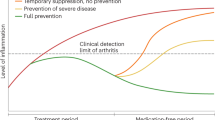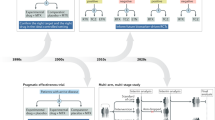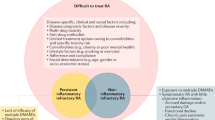Key Points
-
Early treatment initiation in patients with clinically manifest rheumatoid arthritis (RA) is associated with improved disease outcomes; hence, disease modulation in pre-arthritis phases might prevent the occurrence of clinical arthritis
-
The inclusion of patients with a low risk of developing RA might dilute possible preventive effects and result in false-negative results in preventive trials
-
Although a symptomatic phase typically precedes clinical arthritis in patients who develop RA, arthralgia is common and is not specific enough to identify patients at risk of developing RA
-
The EULAR definition of 'arthralgia suspicious for progression to RA', which identifies patients with arthralgia at risk of developing RA, is a good starting position for preventive trial participant selection
-
Adequate stratification of patients with arthralgia at risk of developing RA requires a combination of clinical, serological and imaging markers
Abstract
Early treatment is associated with improved outcomes in patients with rheumatoid arthritis (RA), suggesting that a 'window of opportunity', in which the disease is most susceptible to disease-modifying treatment, exists. Autoantibodies and markers of systemic inflammation can be present long before clinical arthritis, and maturation of the immune response seems to coincide with the development of RA. The pre-arthritis phase associated with symptoms such as as joint pain without clinical arthritis (athralgia) is now hypothesized to fall within the aforementioned window of opportunity. Consequently, disease modulation in this phase might prevent the occurrence of clinically apparent arthritis, which would result in a persistent disease course if untreated. Several ongoing proof-of-concept trials are now testing this hypothesis. This Review highlights the importance of adequate risk prediction for the correct design, execution and interpretation of results of these prevention trials, as well as considerations when translating these findings into clinical practice. The patients' perspectives are discussed, and the accuracy with which RA development can be predicted in patients presenting with arthralgia is evaluated. Currently, the best starting position for preventive studies is proposed to be the inclusion of patients with an increased risk of RA, such as those identified as fulfilling the EULAR definition of 'arthralgia suspicious for progression to RA'.
This is a preview of subscription content, access via your institution
Access options
Access Nature and 54 other Nature Portfolio journals
Get Nature+, our best-value online-access subscription
$29.99 / 30 days
cancel any time
Subscribe to this journal
Receive 12 print issues and online access
$209.00 per year
only $17.42 per issue
Buy this article
- Purchase on Springer Link
- Instant access to full article PDF
Prices may be subject to local taxes which are calculated during checkout


Similar content being viewed by others
References
Smolen, J. S. et al. EULAR recommendations for the management of rheumatoid arthritis with synthetic and biological disease-modifying antirheumatic drugs: 2013 update. Ann. Rheum. Dis. 73, 492–509 (2014).
Combe, B. et al. 2016 update of the EULAR recommendations for the management of early arthritis. Ann. Rheum. Dis. 76, 948–959 (2017).
Boers, M. Understanding the window of opportunity concept in early rheumatoid arthritis. Arthritis Rheum. 48, 1771–1774 (2003).
van Nies, J. A., Tsonaka, R., Gaujoux-Viala, C., Fautrel, B. & van der Helm-van Mil, A. H. M. Evaluating relationships between symptom duration and persistence of rheumatoid arthritis: does a window of opportunity exist? Results on the Leiden Early Arthritis Clinic and ESPOIR cohorts. Ann. Rheum. Dis. 74, 806–812 (2015).
Ajeganova, S. et al. Disease-modifying antirheumatic drug-free sustained remission in rheumatoid arthritis: an increasingly achievable outcome with subsidence of disease symptoms. Ann. Rheum. Dis. 75, 867–873 (2016).
Nielen, M. M. et al. Specific autoantibodies precede the symptoms of rheumatoid arthritis: A study of serial measurements in blood donors. Arthritis Rheum. 50, 380–386 (2004).
Rantapää-Dahlqvist, S. et al. Antibodies against cyclic citrullinated peptide and IgA rheumatoid factor predict the development of rheumatoid arthritis. Arthritis Rheum. 48, 2741–2749 (2003).
Sokolove, J. et al. Autoantibody epitope spreading in the pre-clinical phase predicts progression to rheumatoid arthritis. PLoS ONE 7, e35296 (2012).
van de Stadt, L. A. et al. The value of ultrasonography in predicting arthritis in auto-antibody positive arthralgia patients: a prospective cohort study. Arthritis Res. Ther. 12, R98 (2010).
Nam, J. L. et al. Ultrasound findings predict progression to inflammatory arthritis in anti-CCP antibody-positive patients without clinical synovitis. Ann. Rheum. Dis. 75, 2060–2067 (2016).
van Steenbergen, H. W., Mangnus, L., Reijnierse, M., Huizinga, T. W. J. & van der Helm-van Mil, A. H. M. Clinical factors, anticitrullinated peptide antibodies and MRI-detected subclinical inflammation in relation to progression from clinically suspect arthralgia to arthritis. Ann. Rheum. Dis. 75, 1824–1830 (2016).
van Steenbergen, H. W., Huizinga, T. W. & van der Helm-van Mil, A. H. The preclinical phase of rheumatoid arthritis: what is acknowledged and what needs to be assessed? Arthritis Rheum. 65, 2219–2232 (2013).
Gerlag, D. M. et al. EULAR recommendations for terminology and research in individuals at risk of rheumatoid arthritis: report from the Study Group for Risk Factors for Rheumatoid Arthritis. Ann. Rheum. Dis. 71, 638–641 (2012).
van Nies, J. A. et al. What is the evidence for the presence of a therapeutic window of opportunity in rheumatoid arthritis? A systematic literature review. Ann. Rheum. Dis. 73, 861–870 (2014).
Dekkers, J. S., Schoones, J. W., Huizinga, T. W., Toes, R. E. & van der Helm-van Mil, A. H. Possibilities for preventive treatment in rheumatoid arthritis? Lessons from experimental animal models of arthritis: a systematic literature review and meta-analysis. Ann. Rheum. Dis. 76, 458–467 (2017).
Bos, W. H., Dijkmans, B. A., Boers, M., van de Stadt, R. J. & Schaardenburg, D. Effect of dexamethasone on autoantibody levels and arthritis development in patients with arthralgia: a randomised trial. Ann. Rheum. Dis. 69, 571–574 (2010).
Gerlag, D. M. et al. A single infusion of rituximab delays the onset of arthritis in subjects at high risk of developing RA [abstract]. Arthritis Rheumatol. 68, (Suppl. 10), 3028 (2016).
van Dongen, H. et al. Efficacy of methotrexate treatment in patients with probable rheumatoid arthritis: a double-blind, randomized, placebo-controlled trial. Arthritis Care Res. 56, 1424–1432.
Burgers, L. E., Allaart, C. F., Huizinga, T. W. J. & van der Helm-van Mil, A. H. M. Brief Report: Clinical trials aiming to prevent rheumatoid arthritis cannot detect prevention without adequate risk stratification: a trial of methotrexate versus placebo in undifferentiated arthritis as an example. Arthritis Rheumatol. 69, 926–931 (2017).
Harrison, B. J., Symmons, D. P., Brennan, P., Barrett, E. M. & Silman, A. J. Natural remission in inflammatory polyarthritis: issues of definition and prediction. Rheumatology 35, 1096–1100 (1996).
van Aken, J. et al. Comparison of long term outcome of patients with rheumatoid arthritis presenting with undifferentiated arthritis or with rheumatoid arthritis: an observational cohort study. Ann. Rheum. Dis. 65, 20–25 (2006).
van der Helm-van Mil, A. H. M. et al. A prediction rule for disease outcome in patients with recent-onset undifferentiated arthritis: how to guide individual treatment decisions. Arthritis Rheum. 56, 433–440 (2007).
van der Helm-van Mil, A. H. M. et al. Validation of a prediction rule for disease outcome in patients with recent-onset undifferentiated arthritis: moving toward individualized treatment decision-making. Arthritis Rheum. 58, 2241–2247 (2008).
Aletaha, D. et al. 2010 rheumatoid arthritis classification criteria: an American College of Rheumatology/European League Against Rheumatism collaborative initiative. Ann. Rheum. Dis. 69, 1580–1588 (2010).
Newsum, E. C., van der Helm-van Mil, A. H. & Kaptein, A. A. Views on clinically suspect arthralgia: a focus group study. Clin. Rheumatol. 35, 1347–1352 (2016).
Stack, R. J. et al. Perceptions of risk and predictive testing held by the first-degree relatives of patients with rheumatoid arthritis in England, Austria and Germany: a qualitative study. BMJ Open 6, e010555 (2016).
Sparks, J. A. et al. Randomized controlled trial of rheumatoid arthritis risk disclosure personalized to genetics, autoantibodies, and lifestyle among unaffected first-degree relatives: the Personalized Risk Estimator for RA (PRE-RA) family study [abstract]. Arthritis Rheumatol. 68 (Suppl. 10), 989 (2016).
Finckh, A., Escher, M., Liang, M. H. & Bansback, N. Preventive treatments for rheumatoid arthritis: issues regarding patient preferences. Curr. Rheumatol. Rep. 18, 51 (2016).
Smith, S. G. et al. Factors affecting uptake and adherence to breast cancer chemoprevention: a systematic review and meta-analysis. Ann. Oncol. 27, 575–590 (2016).
Naderi, S. H., Bestwick, J. P. & Wald, D. S. Adherence to drugs that prevent cardiovascular disease: meta-analysis on 376,162 patients. Am. J. Med. 125, 882–887.e1 (2012).
Bonita, R., Beaglehole, R. & Kjellström, T. Basic Epidemiology 2nd edn (World Health Organization, 2006).
Frisell, T. et al. Familial risks and heritability of rheumatoid arthritis: role of rheumatoid factor/anti-citrullinated protein antibody status, number and type of affected relatives, sex, and age. Arthritis Rheum. 65, 2773–2782 (2013).
Hemminki, K., Li, X., Sundquist, J. & Sundquist, K. Familial associations of rheumatoid arthritis with autoimmune diseases and related conditions. Arthritis Rheum. 60, 661–668 (2009).
Scott, D. L., Wolfe, F. & Huizinga, T. W. Rheumatoid arthritis. Lancet 376, 1094–1108 (2010).
National Audit Office. Services for people with rheumatoid arthritis. National Audit Office http://www.nao.org.uk/report/services-for-people-with-rheumatoid-arthritis/ (2009).
van den Dungen, C. et al. What factors explain the differences in morbidity estimations among general practice registration networks in the Netherlands? A first analysis. Eur. J. Gen. Pract. 14(Suppl. 1), 53–62 (2008).
Emery, P. et al. Early referral recommendation for newly diagnosed rheumatoid arthritis: evidence based development of a clinical guide. Ann. Rheum. Dis. 61, 290–297 (2002).
van Steenbergen, H. W. & van der Helm-van Mil, A. H. Clinical expertise and its accuracy in differentiating arthralgia patients at risk for rheumatoid arthritis from other patients presenting with joint symptoms. Rheumatology 55, 1140–1141 (2016).
van Steenbergen, H. W. et al. Characterising arthralgia in the preclinical phase of rheumatoid arthritis using MRI. Ann. Rheum. Dis. 74, 1225–1232 (2015).
van Steenbergen, H. W. et al. EULAR definition of arthralgia suspicious for progression to rheumatoid arthritis. Ann. Rheum. Dis. 76, 491–496 (2017)
Burgers, L. et al. OP0073 Performance of the eular definition of arthralgia suspicious for progression to rheumatoid arthritis — a longitudinal study [abstract]. Ann. Rheum. Dis. 76 (Suppl. 2), 82 (2017).
Hensvold, A. H. et al. How well do ACPA discriminate and predict RA in the general population: a study based on 12 590 population-representative Swedish twins. Ann. Rheum. Dis. 76, 119–125 (2017).
van Zanten, A. et al. Presence of anticitrullinated protein antibodies in a large population-based cohort from the Netherlands. Ann. Rheum. Dis. 76, 1184–1190 (2017).
Haji, Y., Rokutanda, R., Kishimoto, M. & Okada, M. Anti-cyclic citrullinated protein antibody (ACPA) positivity in general population and follow-up results for ACPA positive persons [abstract]. Arthritis Rheumatol. 68 (Suppl. 10), 512 (2016).
van de Stadt, L. A., Witte, B. I., Bos, W. H. & van Schaardenburg, D. A prediction rule for the development of arthritis in seropositive arthralgia patients. Ann. Rheum. Dis. 72, 1920–1926 (2013).
Rakieh, C. et al. Predicting the development of clinical arthritis in anti-CCP positive individuals with non-specific musculoskeletal symptoms: a prospective observational cohort study. Ann. Rheum. Dis. 74, 1659–1666 (2015).
de Hair, M. J. et al. Smoking and overweight determine the likelihood of developing rheumatoid arthritis. Ann. Rheum. Dis. 72, 1654–1658 (2013).
van de Stadt, L. A. et al. Development of the anti–citrullinated protein antibody repertoire prior to the onset of rheumatoid arthritis. Arthritis Rheum. 63, 3226–3233 (2011).
Rombouts, Y. et al. Anti-citrullinated protein antibodies acquire a pro-inflammatory Fc glycosylation phenotype prior to the onset of rheumatoid arthritis. Ann. Rheum. Dis. 74, 234–241 (2015).
Rombouts, Y. et al. Extensive glycosylation of ACPA-IgG variable domains modulates binding to citrullinated antigens in rheumatoid arthritis. Ann. Rheum. Dis. 75, 578–585 (2016).
Kleyer, A. et al. High prevalence of tenosynovial inflammation before onset of rheumatoid arthritis and its link to progression to RA — a combined MRI/CT study. Semin. Arthritis Rheum. 46, 143–150 (2016).
Janssen, K. M. J. et al. Regulatory CD4+ T-cell subsets and anti-citrullinated protein antibody repertoire: potential biomarkers for arthritis development in seropositive arthralgia patients? PLoS ONE 11, e0162101 (2016).
van Beers-Tas, M. H., Marotta, A., Boers, M., Maksymowych, W. P. & van Schaardenburg, D. A prospective cohort study of 14-3-3η in ACPA and/or RF-positive patients with arthralgia. Arthritis Res. Ther. 18, 76 (2016).
Lübbers, J. et al. Changes in peripheral blood lymphocyte subsets during arthritis development in arthralgia patients. Arthritis Res. Ther. 18, 205 (2016).
Chalan, P. et al. Circulating CD4+CD161+ T lymphocytes are increased in seropositive arthralgia patients but decreased in patients with newly diagnosed rheumatoid arthritis. PLoS ONE 8, e79370 (2013).
van Baarsen, L. G. et al. Gene expression profiling in autoantibody-positive patients with arthralgia predicts development of arthritis. Arthritis Rheum. 62, 694–704 (2010).
Kolfenbach, J. R. et al. A prospective approach to investigating the natural history of preclinical rheumatoid arthritis (RA) using first-degree relatives of probands with RA. Arthritis Care Res. 61, 1735–1742 (2009).
National Institute for Health Research, Manchester Musculoskeletal Biomedical Research Unit. Pre-clinical evaluation of novel targets in RA. PREVeNT RA http://www.preventra.net/ (2017).
FNSNF. Arthritis-Checkup: Study of an early detection of the disease. Arthritis-Checkup http://www.arthritis-checkup.ch/index_gb/ (2017).
El-Gabalawy, H. S. et al. Immunogenetic risks of anti-cyclical citrullinated peptide antibodies in a North American native population with rheumatoid arthritis and their first-degree relatives. J. Rheumatol. 36, 1130–1135 (2009).
ISRCTN registry. ISRCTN46017566 Arthritis prevention in the pre-clinical phase of rheumatoid arthritis with abatacept. BioMed Central http://dx.doi.org/10.1186/ISRCTN46017566 (2015).
US National Library of Medicine. ClinicalTrials.gov http://clinicaltrials.gov/ct2/show/NCT02778906 (2016).
Nederlands Trial Register.Trialregister.nl http://www.trialregister.nl/trialreg/admin/rctview.asp?TC=4853 (2014).
Nederlands Trial Register. Trialregister.nl http://www.trialregister.nl/trialreg/admin/rctview.asp?TC=5265 (2015).
US National Library of Medicine. ClinicalTrials.gov http://clinicaltrials.gov/ct2/show/NCT02603146 (2017).
Acknowledgements
The authors of this Review are supported by grants from the Netherlands Organization for Health Research and Development (Vidi grant) and European Research Council (ERC Starting grant). The funding sources had no role in the writing of the manuscript.
Author information
Authors and Affiliations
Contributions
All authors wrote the article, provided substantial contributions to discussions of its content, and undertook review and/or editing of the manuscript before submission.
Corresponding author
Ethics declarations
Competing interests
The authors declare no competing financial interests.
Rights and permissions
About this article
Cite this article
van Steenbergen, H., da Silva, J., Huizinga, T. et al. Preventing progression from arthralgia to arthritis: targeting the right patients. Nat Rev Rheumatol 14, 32–41 (2018). https://doi.org/10.1038/nrrheum.2017.185
Published:
Issue Date:
DOI: https://doi.org/10.1038/nrrheum.2017.185
This article is cited by
-
Stakeholder perceptions of preventive approaches to rheumatoid arthritis: qualitative study of healthcare professionals’ perspectives on predictive and preventive strategies
BMC Rheumatology (2023)
-
Rheumatoid arthritis prevention in arthralgia: fantasy or reality?
Nature Reviews Rheumatology (2023)
-
Revisiting articular syndrome in the peri-pandemic COVID-19 era
Rheumatology International (2023)
-
Is interleukin-17 implicated in early knee osteoarthritis pathogenesis as in rheumatoid arthritis?
Egyptian Rheumatology and Rehabilitation (2022)
-
Acceptability of predictive testing for ischemic heart disease in those with a family history and the impact of results on behavioural intention and behaviour change: a systematic review
BMC Public Health (2022)



